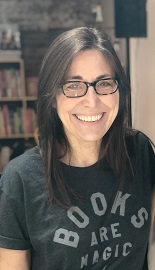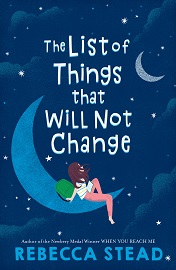- Categories:
Rebecca Stead on Spring Kids’ Indie Next List Top Pick “The List of Things That Will Not Change”
- By Emily Behnke
Indie booksellers across the country have chosen Rebecca Stead’s The List of Things That Will Not Change (Wendy Lamb Books) as a top pick for the Spring 2020 Kids’ Indie Next List.

“Rebecca Stead masterfully captures the voice of middle-schooler Bea, who struggles with anxiety and doesn’t always handle her emotions without some kind drama,” said Lisa Nagel of Eight Cousins in Falmouth, Massachusetts. “Things kick into high gear when her parents announce they are divorcing, and her dad tries to incorporate his partner, Jesse, and his daughter into the family. Stead’s latest sensitively deals with issues of gay marriage and blended families, as well as anxiety and coping with one’s emotions. Highly recommend.”
Here, Bookselling This Week discusses mental health and family with Stead.
Bookselling This Week: Where did the idea for The List of Things That Will Not Change come from?
Rebecca Stead: So many places. My idea-generating process can be summed up as “collection”—of images, fun facts, wishes, memories, questions, and so on. Bea’s home life—divorced parents, the two-apartment arrangement—is how I grew up. Her eczema and deep longing for a sister are also semi-autobiographical. But many of the details that flesh out the world of the story—including the list named in the title—came from other people’s experiences. And the oyster-related aspects came while I was researching New York City high schools. Once I start writing, lots of small ideas show up and seem to attract or repel one another, like mysterious story magnets.
BTW: How did you craft Bea’s character?
RS: By writing without a plan. I create characters by scribbling scene after scene in which they talk and do things. I use the word “scribble” for two reasons: one, I write longhand, and, two, I’m usually writing quickly because I’m trying to outrun the hypercritical voices that live in my head. By the time I have a hundred-ish pages, I’m beginning to know my characters. Then the long process of revision starts. For this book, revision meant letting Bea’s complex emotional life stay at the center of the story.
BTW: The story begins with Bea sharing an anecdote about her father and uncle being able to hear corn grow near their childhood home in Minnesota. Why begin there?
RS: I love the idea that Bea, just hanging out making pancakes with her dad, hears a small story that allows a big piece of understanding to fall into place for her. What she’s understanding is something about the nature of love—it’s small, but it’s big. This is how I experience life most of the time—little human-to-human exchanges often resonate. And I’m pretty much doomed to create stories that represent my way of experiencing the world. That’s a writer’s job, I think.
BTW: Bea deals with feelings of anxiety and immense guilt, which she sees a therapist for. Do you often explore issues of mental health in your writing?
RS: I think mental health is something that concerns every person on earth. As a kid, I was really preoccupied by the fact that I am absolutely alone inside my head. I’m not sure I’ll ever get over it. A lot of my stories are, in some way, about finding a way to share the burden of a solitary internal experience. Every child feels sadness, and pain, and anger, and guilt, and anxiety. It’s important to share those feelings, and to break down the shame that builds up around normal human emotion.
BTW: This book also deals with homophobia, particularly the ways it crops up in Bea’s conversations with classmates and family. Why did you decide to explore this issue through the eyes of a 10-year-old?
RS: Because 10-year-olds are exposed to prejudice as much as anyone else, if not more. It’s one of the things kids process as they build their understanding of the world and of themselves. Worries about bigotry and concern about the withdrawal of love are often deeply rooted in childhood.
BTW: Many of the children in this book yearn for a strong family, even a nontraditional one. Can you talk about the importance of exploring different types of families in children’s literature?
RS: This is something I see coming up in my work again and again, although I have no conscious goal to write about it. I didn’t grow up in a traditional family, but, like Bea, I grew up in a strong and loving untraditional family. It’s important for kids to know that these exist, whether they are living in a “traditional” situation or not. It’s also important to know that love and a nourishing, wonderful family life can be found outside of the family you grew up with. It would be great if every kid could be reassured that his family will love him forever, no matter what. But that’s not true for every person.
BTW: What role do indie bookstores play in your life?
RS: I have spent time in independent bookstores since I was tiny—I have strong memories of lying on the rug at New York’s Womanbooks on Amsterdam Avenue in the 1970s, and of peeking at my mom through the tiny window halfway up the stairs at The New Yorker Bookshop just off Broadway. I met Madeleine L’Engle at Books & Company on the east side when I was 11. (And said nothing, I believe. I just stared.) I was a quiet kid in bookstores, my neck bent to read the titles on the spines. I read entire books on the floor.
As an adult, however, I find I can’t shut up in bookstores. If someone is holding something I’ve read, or something I want to read, my mouth just starts a conversation. I guess I feel an immediate connection to people in bookstores. At Oblong Books in Millerton, New York, I recently loaded up one poor girl with at least six books I wanted her to read. We had met about 10 seconds earlier. And, of course, as a writer for children, I feel enormous gratitude toward independent booksellers, because they create the reading communities that make books possible.

